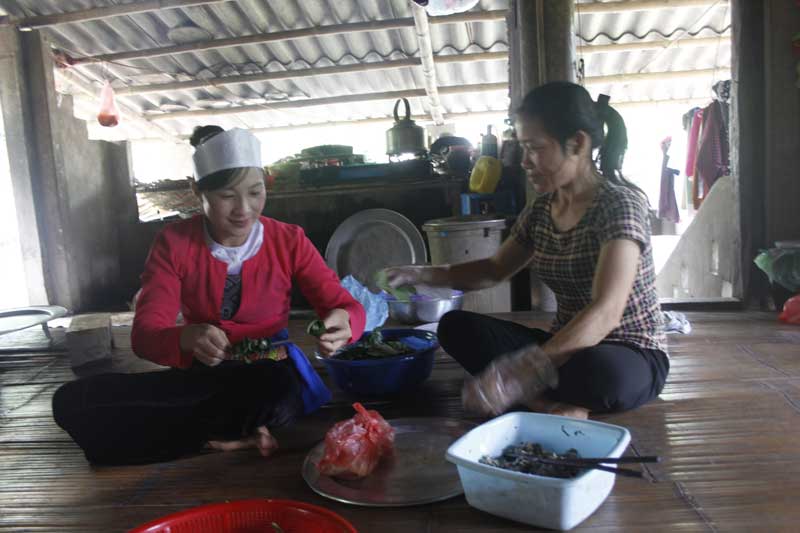
(HBO) – We visited the family of Bui Thi Su in Ai hamlet, Phong Phu commune, Tan Lac district, Hoa Binh province on a day when they were serving a group of 26 French tourists. The visitors came here from Hanoi and had lunch at Su’s house. As scheduled, they would visit Mai Chau after lunch and leave for Thanh Hoa province. Su cooked tofu with tomato sauce and wrapped betel leaves with pork for the guests while her daughter cleaned the house.
Ms. Bui Thi Su is preparing food for tourists.
Su said "Some foreign tourists just like simple
food such as roasted meat, tofu, stir-fried and boiled vegetables. Only few
want to taste traditional dishes of Muong ethnic people. In the past, when Ai
hamlet had not planned to build a community-based tourism village, my family
worked on a farm. The whole family earned a living through rice and crop cultivation
and forestry. In free time, we had to do other jobs to increase income. Thanks
to the State support, my family borrowed loans to upgrade our house, rearrange
cages for buffalos, cows and pigs, and build a toilet”.
Currently, on average, each month, Su’s family
welcomes 5-10 tourist groups. Apart from collecting 160,000 VND from each guest
who stays in her house one day with breakfast and dinner, her family also earns
money from raising cattle and growing vegetables. Excluding expenses, her
family rakes in 4-5 million VND each month. In days without guests, Su and her
spouse could do farming to improve their living.
Ai hamlet has 94 households with over 400
people. In 2016, it was recognised as a community tourism destination with over
50 traditional stilt houses in Muong ancient village.
At present, there are two households in the
hamlet doing community-based tourism. The hamlet could provide a wide range of
services for around 40 foreign tourists or 70 domestic ones such as joining art
performances, learning cooking, experiencing the daily life of locals, fishing,
growing rice, gardening, walking, and cycling./.
The People’s Committee of Lac Son district held a ceremony on April 28 to receive the provincial relic certificate for the ancient rock carving site at Suoi Co stream, located in My Thanh commune.
A special music show titled "The country is in the fullness of joy” has been held at Hoa Binh Square in Hoa Binh city in celebration of the 50th anniversary of the liberation of the South and national reunification (April 30, 1975–2025).
The People's Committee of Lo Son commune, Tan Lac district, has organised the local annual traditional stream fishing festival on April 19 - 20.
As a land deeply intertwined with human history and Vietnam’s millennia-long journey of nation-building and defence, Hoa Binh is often revered for its epic tales and legends.
Residents of Hoa Binh boast a rich cultural identity, reflected in their unique language, traditional attire, customs, and folk melodies – described as "sweet as honey, clear as a mountain stream.”
Lac Son district’s Vu ban town held the 2025 Truong Kha temple festival on April 12–13 (the 15th–16th days of the third lunar month). Since its revival in 2019, the festival has been organised every three years, preserving valuable intangible heritage while meeting the community’s cultural and spiritual needs.



